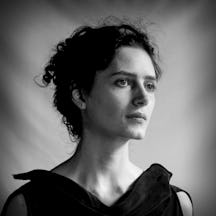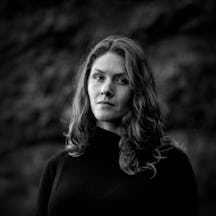As a teenager about to have her scoliosis corrected, Rosalind Jana made herself a garment that highlighted the curvature she’d spent so long concealing. As she did so, she felt elation as she looked to the future.
I am 15 and it’s a perfect autumn weekend. I’m sitting on my bedroom floor tracing and snipping out a series of vertebrae-shaped pieces of raw white silk. I’m about to tack them to the back of a plain black cotton dress – stacked vertically in a lopsided, curving line that’ll look something like a squashed question mark on completion.
When I try it on, my body will distort the shape of this sinuous stitched spine further – my ribcage humped outwards on the left, my right shoulder blade straining sharp against the fabric. The shape will almost perfectly map the backbone beneath; the one which, several days hence, will be seen up close by the surgeon tasked with breaking me apart and putting me back together again.
This dress is being made for my fashion blog, which I’ve had for a year and a half. There I post pictures of myself in a variety of ridiculous get-ups. For the last six months, this has become increasingly fraught. Ever since my back began to properly, painfully twist – no, ever since my curvature was first noticed by my mum when a white vintage blouse wouldn’t sit smoothly over the suddenly abnormal hump of my ribcage – I’ve been trying to hide everything I’m about to so very visibly reveal.
More: Why true wellness sometimes lies in not thinking about wellness at all.
The dress, as I’ll note, is a homage to designer Alexander McQueen, who returns repeatedly to the spine as a motif, usually ensuring it overlays the wearer’s own. I particularly love his spring/summer 1998 collaboration with jeweller Shaun Leane on a metal corset comprised of ribcage and vertebrae, as well his spring/summer 2009 forays into kaleidoscopic prints of backbones on dresses and jackets. Now I want to do something similar.

Pain and rehabilitation
I’d been diagnosed with scoliosis earlier that same year. Scoliosis is a sideways curvature of the spine, vertebrae kinking to the right or left (or, in some cases, both) – often for no known reason. Kyphosis is a rounded, forward curvature. The kind that historically led to people being labelled hunchbacks.
By the time my spine was operated on, my degree of curvature stood at approximately 80 degrees: my torso tightly bent, my daily discomfort levels almost unbearable. During surgery my back was opened up, a section of vertebrae manually straightened and bolted tight with metal rods before being fused solid with artificial bone grafts.
I became a fragile, raw thing – my limbs no longer my own to move at will. I spent a night in intensive care flighted by morphine, a week in hospital breathing minute by minute through the kind of excruciating pain memory kindly mutes in retrospect, and several months shuffling slowly from complete debilitation back towards physical independence. It was terrifying and frustrating and agonising. It was miraculous. It gave me back my life.
Since then I’ve been fascinated by how illness and visual identity interact – especially in the intricate negotiations forged between clothes and body. What we wear so often takes on particularly charged meaning when that body becomes unruly, subject to sudden, bewildering limitations or changes. Perhaps the relationship forged is newly fraught, or defiant. Perhaps it offers much-needed power. In my case, it was all the above.

Clothing a changing body
As my torso first twisted, I desperately wanted my clothes to disguise the worst of my back: wonky shoulders skimmed with loose layers, truncated waistline belted into a semblance of smooth. Regardless, it felt like the contents of my wardrobe were working against me, revealing what I didn’t want seen.
In the immediate aftermath of surgery I was clad in hospital gowns that opened at the back for easy access to my wound. As Sylvia Plath writes in ‘Tulips’, “I am nobody.../ I have given my name and my day-clothes up to the nurses/ and my history to the anaesthetist and my body to surgeons.”
The first morning I could wear my own pyjamas I wept with relief.
For several weeks after leaving hospital, I had to be dressed by my mum, struggling to even lift my arms above my head. Things with buttons were preferable, as were wrap skirts and large cardigans. When I could finally take on this task myself, I did it with gusto: painting my lips red and revelling in items previously laid aside. Doing so was a way of reclaiming how I was seen, of redefining myself anew.

Art as a way of owning illness
Throughout these shifts there were several people I couldn't stop thinking about. One was Frida Kahlo. A predictable point of identification, perhaps, given that, like me, she suffered from scoliosis – albeit for very different reasons (usually interpreted as one of many long-term consequences of the horrific traffic accident she was in aged eighteen).
Her approach to dress was closely bound up in her myriad physical challenges: her long skirts an effective way of obscuring her right leg, which was thinner and shorter than her left after contracting polio aged six; her plaster back braces often adorned with intricate, hand-painted patterns and symbols and, in one case, a column running down the middle – a mirror to her 1944 painting ‘The Broken Column’. Her sartorial decisions were bold and canny. They became armour, embodying a complex set of messages about identity, nationality and gender, as well as disability.
The braces particularly intrigued me. The idea is that such devices halt the progression of a spine’s curvature, but they are not commonly used in the UK, so I’d avoided experiencing those particularly rigid limitations. The poet Edith Sitwell described hers as “my Bastille” after spending her early adolescence in a fabric and steel one to try and correct her scoliosis.
Andy Warhol, who had to wear surgical corsets to hold together his bowels after being shot by Valerie Solanas, dyed his a series of confectionery colours: berry pink, sherbet-lemon yellow, Parma Violet blue. In the case of both Warhol and Kahlo, these medical devices were individualised – necessity vividly transformed into adornment.
I think perhaps that’s what I wanted to do too, on that autumn day with its fierce, gleaming light. There was nothing practical about the garment itself. But making something rudimentary of my own – something strange and beautiful and shocking, something to fit over my body and fully externalise its contortions – still felt elating. Awful and elating and final. It required me to take ownership of what was happening, to step forwards, freshly armoured, into the unknown.
About the contributors
Rosalind Jana
Rosalind is a freelance journalist, author, poet, and speaker whose work has featured in British Vogue, Vogue International, Stylist, the Guardian, Broadly, Refinery29 and the Debrief, as well as on Radio 4 – covering areas from clothes to culture to health to travel.
Camilla Greenwell
Camilla Greenwell is a photographer specialising in dance, performance and portraiture. She regularly works with Sadler’s Wells, Barbican, Candoco, Rambert, The Place, the Guardian, the British Red Cross, Art on the Underground and Wellcome Collection.


